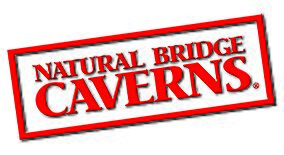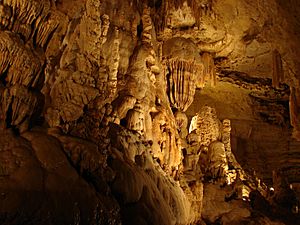Natural Bridge Caverns facts for kids
Quick facts for kids Natural Bridge Caverns |
|
|---|---|
 |
|
| Location | Comal County, Texas, United States |
| Nearest city | San Antonio |
| Established | July 3, 1964 (Discovered in March 1960) |
| Website | https://naturalbridgecaverns.com |
| Designated: | 1971 |
The Natural Bridge Caverns are the biggest known commercial caves in the U.S. state of Texas. The name comes from a 60-foot natural limestone bridge. This bridge stretches over the entrance to the caverns. It was formed when a sinkhole collapsed below it, leaving the rock span hanging.
These amazing caverns are found near San Antonio, Texas. They are in the Texas Hill Country, right next to the Natural Bridge Wildlife Ranch. This ranch is a fun drive-through safari park where you can see wild animals.
Inside the caverns, you'll find many unique speleothems. These are special rock formations. The temperature inside the cave stays at a cool 21 degrees Celsius (70°F) all year. The air is also very humid, at 99 percent. The deepest part of the public tour is 180 feet below the ground. However, some parts of the cavern go even deeper, reaching 230 feet.
The caverns are still growing, very slowly. Rainwater seeps down through the limestone rock. As it moves, it dissolves a soft mineral called calcite. Calcite is what all the beautiful formations in Natural Bridge Caverns are made of. When the water enters the caverns, it drips and flows constantly. This keeps the formations looking shiny and waxy, which is rare to see in caves.
Contents
Discovering the Caverns
The Natural Bridge Caverns were first found on March 27, 1960. Four students from St. Mary's University in San Antonio discovered them. Their names were Orion Knox Jr., Preston Knodell Jr., Al Brandt, and Joe Cantu.
On their fourth trip into the caverns, they explored over a mile of passages. Later explorations found another 2 miles of cave. This part became known as the "North Cavern."
After the discovery, Orion Knox Jr. helped the landowners, the Wuest family. Mrs. Clara Wuest wanted to share the amazing cave with everyone. Orion talked to the National Park Service and the Texas Park System. Both groups agreed the cave was special. But they said they didn't have money to develop it for visitors.
So, Mrs. Wuest decided to fund the development herself. Orion even left school to help. They also got help from Jack Burch, who had worked on the Caverns of Sonora. Development started in 1963. Mrs. Wuest married Harry Heidemann, and together with Jack Burch, Orion Knox, and Reggie Wuest (Mrs. Wuest's son), they worked hard. They added lights and trails. The caverns officially opened on July 3, 1964. The Wuest family still owns and runs the caverns today. In 1971, Natural Bridge Caverns became a special United States National Natural Landmark.
Ancient Discoveries
During the digging of the entrance path, some very old items were found. These included a human tooth, arrowheads, and spearheads. These tools date back to about 5,000 BC. Just inside the entrance, they also found bones from an extinct type of black bear.
These findings suggest that early people and animals might have used the upper parts of the cavern as a shelter. Recently, archaeologists did more digging under the natural bridge. They found more arrowheads and tools. This further proves that ancient people were here a very long time ago.
Exploring Deeper Passages
In 1967, people thought there might be more cave passages to the south. Test drilling confirmed this idea. They found a large open space about 90 feet below the surface. A camera was sent down a narrow hole, and pictures showed a big chamber full of formations.
This hole was made wider, and three men were lowered into the new area. They were Jack Burch, Reggie Wuest, and Myles Kuykendall. They found a large room with many formations. They named this new room the Jaremy Room, using parts of their first names.
Later, near the bottom of the Jaremy Room, they thought another passage might be hidden. In 1968, more drilling was done. Another shaft was sunk about 150 feet underground. This also led to a large open space. This shaft was also widened, and explorers went down. They found another half-mile of cavern stretching to the south. This new part became known as the South Cavern.
Recent Discoveries and Changes
Exploration of the caverns is still happening today! In the summer of 2005, several hundred feet were added to the known length of the cave. Experts believe that even more passages could be mapped in the future. There are still unexplored areas in the "Discovery Passages" (North Cavern).
Since May 8, 2019, a team of cave explorers has found over 1,600 feet of brand new passages. As explorers go deeper, each trip takes longer. The latest expedition took more than 19 hours to complete!
In 2008, the owners of the Caverns changed the names of the main passages. The "North Cavern" is now called the "Discovery Passages." The "South Cavern" is now called the "Hidden Passages." The owners say these new names better describe how the caverns were found and explored. They also help visitors understand the different parts of the cave.
Amazing Cave Wildlife
There is proof that bats live in Natural Bridge Caverns. You can see their roosting areas and bat guano (bat droppings). Nearby, Bracken Cave is home to one of the largest bat colonies in Texas. These bats are a small species called Mexican free-tailed bats.
Bats are very important to our world. They help control insect populations by eating them. They also help pollinate plants, which means they help plants make seeds. And they are a food source for other animals. This makes bats a valuable part of the ecosystem. The cave was even featured on a TV show called Texas Country Reporter in 2013.
Images for kids
-
Tall, thin stalagmites and columns.
-
More tall, thin stalagmites.






























